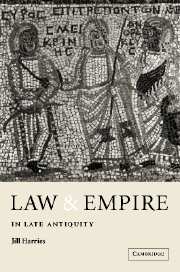Book contents
- Frontmatter
- Contents
- Preface
- Introduction
- 1 The law of Late Antiquity
- 2 Making the law
- 3 The construction of authority
- 4 The efficacy of law
- 5 In court
- 6 Crime and the problem of pain
- 7 Punishment
- 8 The corrupt judge
- 9 Dispute settlement I: out of court
- 10 Dispute settlement II: episcopalis audientia
- Conclusion
- Bibliography
- Index
9 - Dispute settlement I: out of court
Published online by Cambridge University Press: 22 September 2009
- Frontmatter
- Contents
- Preface
- Introduction
- 1 The law of Late Antiquity
- 2 Making the law
- 3 The construction of authority
- 4 The efficacy of law
- 5 In court
- 6 Crime and the problem of pain
- 7 Punishment
- 8 The corrupt judge
- 9 Dispute settlement I: out of court
- 10 Dispute settlement II: episcopalis audientia
- Conclusion
- Bibliography
- Index
Summary
Resort to law was one among several methods of handling or settling disputes between individuals or groups. Although it has come to be recognised that disputes in early mediaeval Europe were settled in a variety of extra-legal ways, alternative means of dispute handling and resolution under the Later Roman Empire have received little systematic attention. Yet a number of methods for ‘finishing’ disputes existed, of which the law took limited, or no, cognisance. These may be listed as force, arbitration, and mediation or negotiation. In cases of public violence, the agencies of law-enforcement became involved only when the situation got so out of hand that the imperial majesty itself was threatened. Formal arbitration involved the law to the extent that a settlement might require enforcement through the state's courts, in the event of a breach of the terms by one or more of the parties, and rules were laid down for some aspects of arbitration, because ‘the praetor’ was required to ensure that the decisions of an arbiter were honoured. Arbitration, however, could also consist of an informal agreement brokered by an adjudicator, without introducing the legal formalities required of a formal process (although legal redress might then be harder to come by). Settling a dispute through mediation by a third party or negotiation between the parties themselves was, by definition, extra-legal. The written law is, naturally, silent on informal and legally unenforceable agreements. This did not, in practice, mean that informal agreements were less binding.
- Type
- Chapter
- Information
- Law and Empire in Late Antiquity , pp. 172 - 190Publisher: Cambridge University PressPrint publication year: 1999

